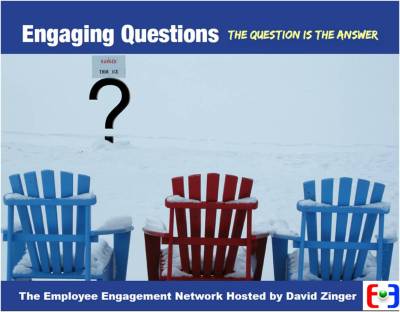Before you can find the right answers, you need to ask the right questions. And that’s just what you get in this free e-book, Engaging Questions: The Question is the Answer, from the Employee Engagement Network.
Whether you need to begin the dialog or explore a specific issue related to employee engagement in your workplace, this e-book is a great source of more than 100 thought-provoking and starter questions.
Here’s a sample:
- Who is responsible for employee engagement? (from Art Bingham, p. 22)
- What would you need to see from management, so you would know that they were as engaged as they want you to be? (from Christine Dunn, p. 39)
- What things do people in your work group do that make you feel connected to your company? (from Tim Houlihan, p. 26)
- When we hire new employees, how can our onboarding process maintain the enthusiasm they have when they accept a position? (from Peggy Foster, p. 8)
- Beyond knowing how many employees work in the company, do top managers know many employees are actually contributing to the company’s success? And what can they do to ensure the second number equals the first? (my question, p. 15).


One reply on “Questions on Employee Engagement”
Employee engagement is not classical employee loyalty: good news! Business and the public sector are into a phase of creative disassembly where reinvention and adjustments are constant. Hundreds of thousands of jobs are being shed by United Technologies, GE, Chevron, Sam’s Club, Wells Fargo Bank, HP, Starbucks etc. and the state, counties and cities. Even solid world class institutions like the University of California Berkeley under the leadership of Chancellor Birgeneau & Provost Breslauer are firing staff, faculty and part-time lecturers. Yet many employees, professionals and faculty cling to old assumptions about one of the most critical relationship of all: the implied, unwritten contract between employer and employee.
Until recently, loyalty was the cornerstone of that relationship. Employers promised job security and a steady progress up the hierarchy in return for employees fitting in, performing in prescribed ways and sticking around. Longevity was a sign of employeer-employee relations; turnover was a sign of dysfunction. None of these assumptions apply today. Organizations can no longer guarantee employment and lifetime careers, even if they want to.
Organizations that paralyzed themselves with an attachment to “success brings success’ rather than “success brings failure’ are now forced to break the implied contract with employees – a contract nurtured by management that the future can be controlled.
Jettisoned employees are finding that the hard won knowledge, skills and capabilities earned while being loyal are no longer valuable in the employment market place.
What kind of a contract can employers and employees make with each other? The central idea is both simple and powerful: the job or position is a shared situation. Employers and employees face market and financial conditions together, and the longevity of the partnership depends on how well the for-profit or not-for-profit continues to meet the needs of customers and constituencies. Neither employer nor employee has a future obligation to the other. Organizations train people. Employees develop the kind of security they really need – skills, knowledge and capabilities that enhance future employability.
The partnership can be dissolved without either party considering the other a traitor..